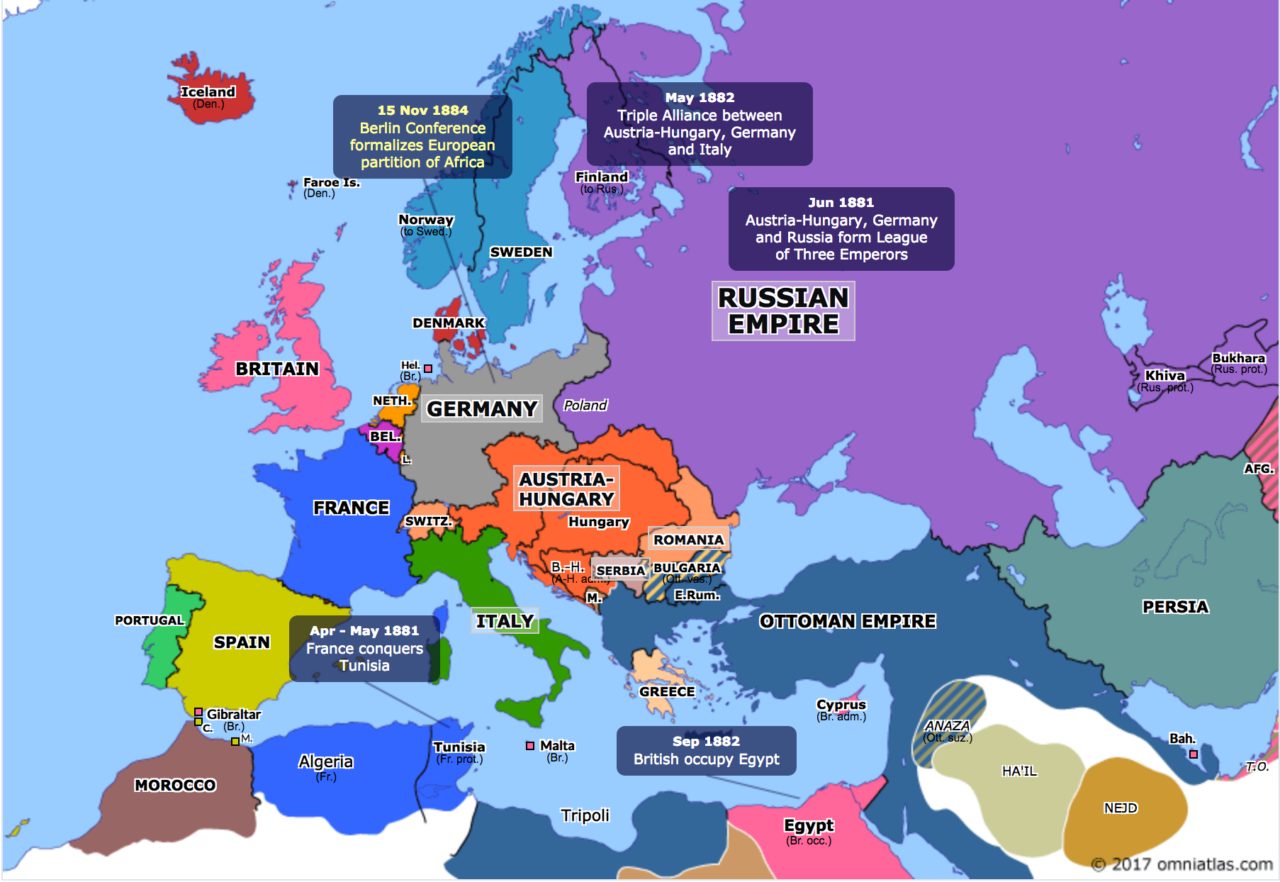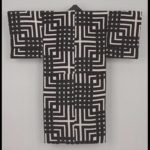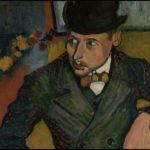OVERVIEW
Extreme bustles, striped patterns, and elaborate embellishments were all staples of the year 1886, characterizing it as a time of highly exaggerated and decorative fashion.
Womenswear
Harper’s Bazar summarized the most desirable trends of 1886 in a June “New York Fashions” column:
“The most fashionable modistes make great use of watered ribbons and of the watered silks that are now marked in wide waves almost equal to those of the moire antique formerly in vogue. Entire dresses are now made of this moire, with the skirt veiled with lace, those of black having the imitation Chantilly laces, and white moire skirts being covered with imitation Valenciennes lace.” (367)
In addition to materials, they also noted that:
“Stripes, sashes, lengthwise pleats, revers, and very bouffant draperies, some of which are long and others very short, are the features that are confirmed for next season’s dresses.” (155)
Overall, 1886 was a year in which silhouettes, textile decoration, and clothing embellishments were all dramatized. As a result, looks from the time remained elegant, yet bold and eye-catching.
Fig. 1 - Wm. Notman & Son (Canadian, 1826-1891). Miss Ethel Bond, 1886. Silver salts on glass - gelatin dry plate process; 17 x 12 cm (6.7 x 4.7 in). Montreal: McCord Museum. Source: McCord Museum
Fig. 2 - Latest-Style House-Dress; Walking-Dress. Peterson's Magazine, May 1886. Engraving; 23 x 14 cm (8.7 x 5.5 in). New York: Mid-Manhattan Picture Collection. Source: NYPL
Fig. 3 - Designer unknown. Wedding dress, 1886. Silk, lace, and cotton. Manchester: Manchester Art Gallery, 1947.4163. Source: Manchester Art Gallery
Fig. 4 - Artist unknown. Portrait, 1886. Montreal: Musée McCord. Source: Pinterest
Fig. 5 - Designer unknown (American). Dress, 1886. Silk. New York: The Met, C.I.47.76.12a–e. Gift of Miss Alice Baldwin Beer, 1947. Source: The Met
One of the most stark differences between the earlier half of the decade and 1886 was the revival of the bustle (Figs. 1-2). Dresses during this year tended to taper at the waistline and then make dramatic extensions at the back, creating a distinct curve. In addition to bustles, trains which trailed behind dresses also became typical (Fig. 3), further expressing the elaborate fashions of the year. As for the top portion of dresses, v-necklines (Fig. 4) became the standard as opposed to more the simpler necklines which had come before 1886.
However, dress shape and form was not the only way in which fashion had become more dramatic throughout the year. Fabrics were frequently patterned, the most desirable including checks, stripes, bars, and plaid. The coloring of these patterns was crucial as well, as Harper’s Bazar (1886) wrote in their July “New York Fashions” column:
“Very yellow browns prevail in all these blocked goods; the combination of red with blue is seen more often in stripes than in the blocks or bars. The genuine Scotch Cheviots are shown in half-inch stripes alternately red and blue, tan with blue, gray with black, and green with brown…The present fancy for black and white mixtures is continued in heavy woollens, showing bars, checks, stripes, and double bars of white on black.” (479)
Muted and neutral colors became extremely popular in 1886 as a way to compliment the abundance of patterns circulating the market (Figs. 5-6).
Towards the end of 1886, the holiday season created a large demand for evening gowns. It was during this time in which decorative trends from the year including using ribbons, braids and beading as a form of embellishment were exaggerated even further. Dresses were decorated through embroidery with precious stones and metallics, creating dresses of grandiose appearance (Figs. 7-8).
Fig. 6 - Designer unknown (American). Day dress, 1886. Sateen, sateen/glazed cotton, and ivory. Lowell: American Textile History Museum. Source: Pinterest
Fig. 7 - Illman Brothers (American). The New Year's Party, Peterson's Magazine, 1886. Hand-colored engraving; 23 x 29 cm (9 x 11.2 in). New York: Mid-Manhattan Picture Collection. Source: NYPL
Fig. 8 - Designer unknown. Day Gown, 1886. Los Angeles, 2009.5.70AB. Source: FIDM Museum & Galleries
John Singer Sargent’s portrait of Mrs Robert Harrison done in 1886 (Fig. 9) faced criticism from the public because the subject’s fashion choices deviated from the standard of the year. Although her dress also displays two trends of the year–heavy amounts of tulle and cuffed sleeves–the public was thrown by the red cloak draped over the dress. The Tate Museum notes that:
“When the portrait was exhibited at the 1886 Royal Academy one commentator exclaimed that she had never seen Mrs Harrison ‘wearing such red wing-like appendages to her costume, which look as though about to expand and convey her to the regions of Mephistopheles.'”
Its loose fit did not conform to the snug, fitted jackets deemed to be fashionable that year, and the triangular, winged cuts on the back of the garment looked alien in comparison to the flowy and draped garments which were so popular.
Fig. 9 - John Singer Sargent (American, 1856–1925). Portrait of Mrs Robert Harrison, 1886. Oil on canvas; 157.8 x 80.3 cm (62.1 x 31.6 in). London: Tate. Source: Tate
Menswear
Fig. 1 - Artist unknown (American). Peterson's Magazine, 1886. New York: Mid-Manhattan Picture Collection. Source: NYPL Digital Collections
Fig. 2 - Paul Cézanne (French, 1839 - 1906). The Artist's Son, Paul, 1886-87. Oil on canvas; 65.3 x 54 cm (25 x 21. 2 in). Washington: National Gallery of Art, 1963.10.100. Source: National Gallery of Art
Fig. 3 - Giuseppe Gabrielli. The National Gallery 1886, Interior of Room 32, 1886. Oil on canvas; 110 x 142 cm (43.3 x 55. 9 in). London: The National Gallery. Source: The National Gallery
Fig. 4 - Wm. Notman & Son (Canadian, 1826-1891). J. M. Martin, 1886. Silver salts on paper mounted on paper - albumen process; 15 x 10 cm (5.9 x 3.9 in). Montreal: Musée McCord Museum. Source: Musée McCord Museum
CHILDREN’S WEAR
Fig. 1 - Jules David (French). Le Moniteur de la Mode, 1886. Hand-colored engraving; 26 x 35.5 cm (10.2 x 14 in). Montreal: L'Affichiste Vintage Poster Gallery. Source: L'Affichiste
Fig. 2 - Wm. Notman & Son (Canadian, 1826-1891). Missie Rainville, 1886. Silver salts on paper mounted on paper - albumen process; 15 x 10 cm (5.9 x 3.9 in). Montreal: Musée McCord Museum. Source: Musée McCord Museum
Fig. 3 - Jules David (French). Le Moniteur de la mode, 1886. New York: Metropolitan Museum of Art. Gift of Woodman Thompson. Source: The Metropolitan Museum of Art
Fig. 4 - Mary Cassatt (American, 1844-1926). Child in a Straw Hat, 1886. Oil on canvas; 65.3 x 49.2 cm (25 x 19 in). Washington: National Gallery of Art, 1983.1.17. Source: National Gallery of Art
References:
- “New York Fashions” Harper’s Bazar 19, no. 1 (January 2, 1886): 8. http://hearth.library.cornell.edu/cgi/t/text/text-idx?c=hearth;idno=4732809_1453_001
- “New York Fashions” Harper’s Bazar 19, no. 8 (February 20, 1886): 123. http://hearth.library.cornell.edu/cgi/t/text/text-idx?c=hearth;idno=4732809_1453_008
- “New York Fashions” Harper’s Bazar 19, no. 23 (June 5, 1886): 367. http://hearth.library.cornell.edu/cgi/t/text/text-idx?c=hearth;idno=4732809_1453_024
- “New York Fashions” Harper’s Bazar 19, no. 23 (July 24, 1886): 479. http://hearth.library.cornell.edu/cgi/t/text/text-idx?c=hearth;idno=4732809_1453_031
- “New York Fashions” Harper’s Bazar 19, no. 37 (September 11, 1886): 591. http://hearth.library.cornell.edu/cgi/t/text/text-idx?c=hearth;idno=4732809_1453_038
- “New York Fashions” Harper’s Bazar 19, no. 47 (November 20, 1886): 759. http://hearth.library.cornell.edu/cgi/t/text/text-idx?c=hearth;idno=4732809_1453_048
-
Tate. “‘Portrait of Mrs Robert Harrison’, John Singer Sargent, 1886.” Tate. Accessed July 22, 2018. https://www.tate.org.uk/art/artworks/sargent-portrait-of-mrs-robert-harrison-t07693.
Historical Context
Wikipedia: 1886
Rulers:
- America:
- President Grover Cleveland (1885-89)
- England: Queen Victoria (1837-1901)
- France:
- President Jules Grévy (1879-87)
- Spain:
- Regent Maria Christina of Austria (1886-1902)
Europe 1884. Source: Omniatlas
Events:
-
- 1886 – Last Impressionist group exhibition
- 1886 – Statue of Liberty is dedicated as a gift
- 1886 – Post-Impressionist works begin being displayed
- 1886 – Georges Seurat finishes painting Sunday Afternoon on the Island of La Grande Jatte
Timeline Entries
Primary/Period Sources
Resources for Fashion History Research
To discover primary/period sources, explore the categories below.
Have a primary source to suggest? Or a newly digitized periodical/book to announce? Contact us!
Fashion Plate Collections (digitized)
- Costume Institute Fashion Plate collection
- Casey Fashion Plates (LA Public Library) - search for the year that interests you
- New York Public Library
NYC-Area Special Collections of Fashion Periodicals/Plates
- FIT Special Collections (to make an appointment, click here)
- Costume Institute/Watson Library @ the Met (register here)
- New York Public Library
- Brooklyn Museum Library (email for access)
Womenswear Periodicals (Digitized)
Etiquette Books (Digitized)
Menswear Periodicals / Etiquette Books (Digitized)
Secondary Sources
Also see the 19th-century overview page for more research sources... or browse our Zotero library.




